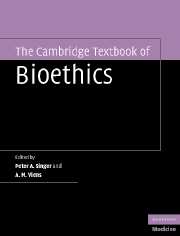Book contents
- Frontmatter
- Contents
- List of contributors
- Acknowledgements
- 1 Introduction
- Section I Information problems
- Section II End of life care
- Introduction
- 8 Quality end of life care
- 9 Substitute decision making
- 10 Advance care planning
- 11 Euthanasia and assisted suicide
- 12 Conflict in the healthcare setting at the end of life
- 13 Brain death
- Section III Pregnant women and children
- Section IV Genetics and biotechnology
- Section V Research ethics
- Section VI Health systems and institutions
- Section VII Using clinical ethics to make an impact in healthcare
- Section VIII Global health ethics
- Section IX Religious and cultural perspectives in bioethics
- Section X Specialty bioethics
- Index
- References
11 - Euthanasia and assisted suicide
Published online by Cambridge University Press: 30 October 2009
- Frontmatter
- Contents
- List of contributors
- Acknowledgements
- 1 Introduction
- Section I Information problems
- Section II End of life care
- Introduction
- 8 Quality end of life care
- 9 Substitute decision making
- 10 Advance care planning
- 11 Euthanasia and assisted suicide
- 12 Conflict in the healthcare setting at the end of life
- 13 Brain death
- Section III Pregnant women and children
- Section IV Genetics and biotechnology
- Section V Research ethics
- Section VI Health systems and institutions
- Section VII Using clinical ethics to make an impact in healthcare
- Section VIII Global health ethics
- Section IX Religious and cultural perspectives in bioethics
- Section X Specialty bioethics
- Index
- References
Summary
Ms. I is 32 years old and has advanced gastric cancer that has resulted in constant severe pain and poorly controlled vomiting. Despite steady increases in her opioid dose, her pain has worsened greatly over the last two days. Death is imminent, but the patient pleads incessantly with the hospital staff to “put her out of her misery.”
Mr. J is a 39-year-old injection drug user with a history of alcoholism and depression. He presents at an emergency department, insisting that he no longer wishes to live. He repeatedly requests euthanasia on the grounds that he is no longer able to bear his suffering (although he is not in any physical pain). A psychiatrist rules out clinical depression.
What are euthanasia and assisted suicide?
Euthanasia has been defined as a deliberate act undertaken by one person with the intention of ending the life of another person to relieve that person's suffering. Euthanasia may be “voluntary,” “involuntary,” or “non-voluntary,” depending on (i) the competence of the recipient, (ii) whether or not the act is consistent with the recipient's wishes (if these are known), and (iii) whether or not the recipient is aware that euthanasia is to be performed. Assisted suicide has been defined as “the act of intentionally killing oneself with the assistance of another who deliberately provides the knowledge, means, or both” (Special Senate Committee on Euthanasia and Assisted Suicide, 1995).
- Type
- Chapter
- Information
- The Cambridge Textbook of Bioethics , pp. 72 - 77Publisher: Cambridge University PressPrint publication year: 2008
References
- 3
- Cited by



